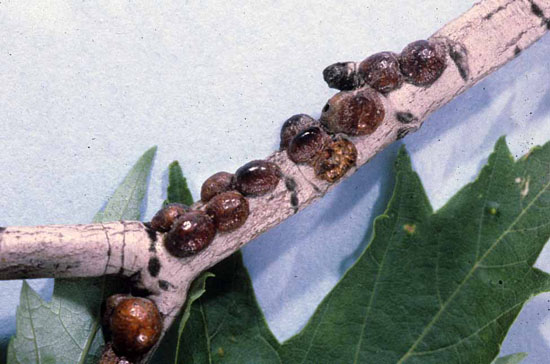Issue 6, May 31, 2016
Lecanium Scale
Lecanium scale, more properly European fruit lecanium, Parthenolecanium corni, continues to build populations throughout the state. Along with borers, a couple of scale insects, scurfy scale and lecanium scale, take advantage of stressed trees. The severe drought of 2012 followed by another drought in the second half of the 2013 growing season caused severe root loss from which trees are still trying to survive. We continue to see increased borer and lecanium scale attack. We have not seen increased scurfy scale infestations. This white scale that prefers tree trunks is most likely to be seen in nurseries.
Despite its name, European fruit lecanium is native to North America. Oak lecanium and Fletcher scale are closely related, identical to European fruit lecanium, and may be the same species. For this reason, they are commonly referred to as the Parthenolecanium corni complex. Oak lecanium feeds on oak; Fletcher scale feeds on arborvitae, juniper, and yew. Besides fruit trees, European fruit lecanium hosts include maple, crabapple, hazel, and many deciduous trees and shrubs.
Mature lecanium scale females look like reddish to dark brown turtle shells or army helmets one-eighth to one-quarter inch in diameter on the twigs and branches of many trees. Female scale mature in the spring and lay white eggs under the scale covers that hatch into pink crawlers. These first stage nymphs remain under the old female shell for several days before emerging to seek feeding sites.

European fruit lecanium scale on silver maple.
The crawlers settle on the leaves where they molt and remain for much of the growing season, returning to the twigs and branches before leaf fall in autumn. Nymphs overwinter on the twigs and branches, molting into adults after feeding in the spring. Males are sometimes produced in the spring to mate with the females, but commonly no males are produced and females reproduce through parthenogenesis, eggs develop and hatch without fertilization.
Lecanium scale are soft scales. Soft scales' outside body walls become thick and hard, remaining as a "shell" after the female dies and the underside soft body parts shrivel and dry up. Their very long mouthparts penetrate bark to feed directly from phloem vessels. Much of the water and some of the carbohydrates are consumed, resulting in large amounts of concentrated sap called honeydew being exuded from the anus.
This honeydew is sticky and supports a sooty mold that coats leaves, branches, sidewalks and vehicles parked under attacked trees. Sticky sidewalks or black branches and leaves are clues to scout closer for soft scale. Armored scale such as oystershell, pine needle, and euonymus scale suck out individual cell contents and do not exude honeydew. Armored scales excrete a protective waxy covering over their soft bodies.
Clientele sometimes ask why it is raining under their lecanium scale infested tree and not elsewhere. Their reactions are interesting when they learn that what they think is rain is bug poop (honeydew). There are a few interesting jokes that circulate about people mistaking excretions for rain, but I will not repeat them.
Being a native species, lecanium scale is attacked by numerous natural enemies including lady beetles and parasitic wasps. When scale populations increase, natural enemy numbers follow. Usually after about three years of noticeably high numbers, lecanium scale numbers crash due to natural enemy control. Drought or other factors reducing tree health apparently initiates subsequent scale population increases.
Heavily attacked branches with lecanium scale frequently die, but some heavily attacked branches survive, making it unclear the cause of the dieback. Because stressed trees typically have more lecanium scale, the dieback may be more from environmental stress than the scale. However, the scale feeding surely adds stress and thus reduces the ability of the tree to recover from drought or other stress. For that reason, scale control is suggested.
Because lecanium and other soft scale tap phloem vessels for food, they are susceptible to systemic insecticides. Application of imidacloprid (Merit and others) or dinotefuran (Safari) is effective in controlling lecanium during the growing season. The overwintering female nymphs are also susceptible to dormant oil spray, and this is generally the most effective way to control this scale.
Crawler sprays are also effective. Spraying the trees with insecticidal soap, summer spray oil, bifenthrin (Onyx), cyfluthrin (Tempo) or acephate (Orthene) at crawler emergence and again two weeks later will provide control. Acephate, being systemic through the leaves, is particularly effective on settled scale. Crawlers emerge when Queen Anne's lace is in bloom, usually in mid-June in central Illinois. This will generally be two weeks earlier in southern Illinois and two weeks later in northern Illinois. (Phil Nixon)
Author:
Phil Nixon